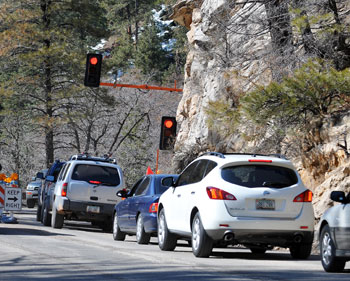Before one of Bob Matthews’ students signed up for a tracking class, a morning’s walk around his property to examine the prior night’s activities chewed up an hour and a half.
After the class, it took three hours.
“There was so much I was missing,” the student said.
Matthews is now offering the same class at Yavapai College in Sedona.
Participants will learn how to spot every sort of track from kangaroo mice to mountain lions, with bears, javelina, deer, rabbits, skunks, rattlesnakes and porcupines in between.
Even those with only a casual interest in reading the ground will enjoy spending time with this Englishman who’s lived in Morocco, Israel and Africa, learning from people whose lives depended on their tracking skills.
As a child growing up in the little village of Sutton in the south of England, Matthews learned how to find pheasants, rabbits and deer from his father, formerly an Abedare ranger who fought in the Mau Mau uprising and lived off the land behind enemy lines for years.
The boy also learned from Romany gypsy tribes how to fend for himself in the woods, learning which animals prey on others along with their respective habits.
From there, he went to Israel where he lived for two years, hanging out with the Bedouin tribes working for that country’s military defending the border.
“The Bedouins are the best desert survivalists there are,” Matthews said. “They taught me how to look at sand and be able to tell everything that happened there in the last two weeks.”
Bouncing Betty land mines set beneath palm fronds were some of the things providing strong motivation for the tribes to become experts in tracking.
Back home in England, an argument with a customer in his father’s pub sent Matthews to Morocco where his education as a herpetologist was refined by working with king cobra snakes, considered among the deadliest on the planet.
It was there that he met the nomadic Touaregs, traveling with them through the Sahara, a journey interrupted by a jihad issued by King Hassan II.
“Touaregs are the ultimate warriors,” Matthews said. “They’re very skilled in desert warfare and if you have one on your butt, it won’t be long before they find you.”
When Matthews isn’t teaching backcountry survival or providing counseling for troubled youth and families, he works as a consultant for the military and for law enforcement, providing private training for individuals, and tracking wildlife for ranchers.
“Once I understand what’s happening, I can suggest solutions,” he explained.
Matthews currently lives in Prescott where one of his clients is a large rancher with a mountain lion problem.
“The owners are true stewards of the land in Arizona; they’ve had their ranch for 120 years,” he said. “Their preference is to move the cows or convince the predators to go elsewhere rather than harm the wildlife.”
While some people advocate man-made deterrents to make an animal feel unwelcome, Matthews prefers to take one step up the food chain.
“The animal world is very simple. Bears kill more of each other than anything else,” he said. “So, if you have a black bear problem, all you need is grizzly scat.”
It isn’t necessary to travel far afield to appreciate the tracker’s skills.
Less than 100 feet behind the Yavapai College campus in Sedona, he used a hiking stick to point out loose dirt where small stones had broken off the crust.
“The slide shows you a cottontail went down this slope,” he said.
A few feet further along, he found the tracks of javelina under some junipers, a mountain lion track in the cinders along the road and coyote scat knit together with the fur of a rabbit.
“Javelina have babies year-round, they travel together 20-30 in a group, so you’ve always got lions following them around.”
Matthews’ Introduction to Tracking [REC 102] is a compact course with two components:
A two-hour orientation at the Sedona Center for Arts and Technology scheduled for Thursday, Oct. 1, from 5:30 to 7:30 p.m.
A three-day, two-night camping-based field trip in the Coconino National Forest beginning Thursday, Oct. 8 through Saturday, Oct. 10.
Matthews said there are nearby bathrooms, no major hiking is involved and the college supplies all of the camping gear.
The one-credit course costs $58 and is a great opportunity to experience and see the outdoors in an entirely new way.
The course covers basic tracking through the use of field experiences as they relate to the wild areas and wildlife of Yavapai County.
To sign up for Introduction to Tracking, go online to register at www.yc.edu, visit a Yavapai College campus, or call (928) 776-2199.
Susan Johnson can be reached at 282-7795, ext. 129, or e-mail sjohnson@larsonnewspapers.com





















